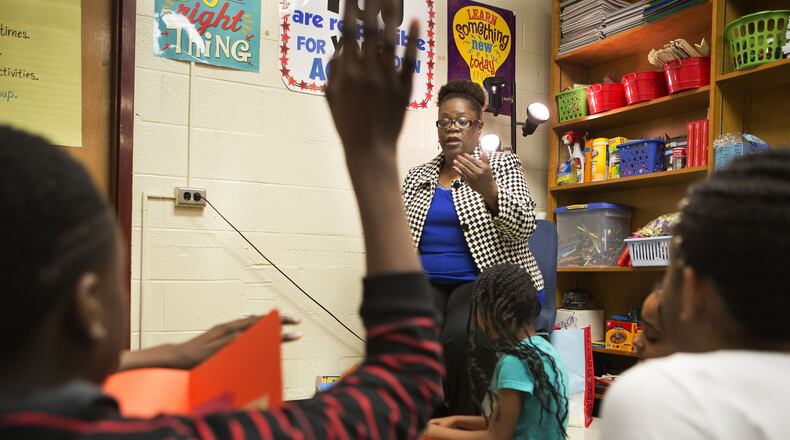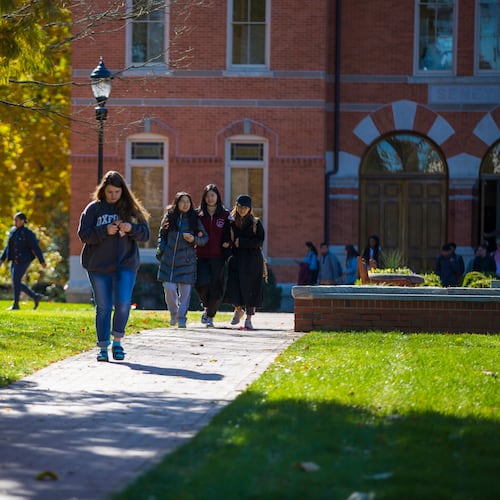When an apartment complex in south DeKalb County closed suddenly this fall, it burdened social service agencies that scrambled to find alternative housing for the impoverished tenants.
It also forced a school to shift from its focus on education. Jennelle Savoy, the social worker at Flat Shoals Elementary School, heard that some of her students lived in the trash-strewn compound, but she was unprepared for the actual number: around 50.
“We were like, whoa, whoa. We had no idea there were that many people,” Savoy said. “We thought there were going to be maybe 10 at most.”
The school helped find new housing and MARTA passes for the families. District employees donated luggage and sought clean clothes for students whose parents had no way to wash. Word spread among teachers: give these kids a break if they are late with homework or need to lay their heads on their desks to nap.
Flat Shoals and other schools packed with poor students highlight a challenge for teachers as poverty rises outside school doors: how to provide extra services that can put the poorest students on a stable footing so they can learn. It’s a foreign problem for middle class schools, but politicians across Georgia will likely have to grapple with it when the General Assembly starts Jan. 9. Gov. Nathan Deal is expected to propose a sweeping overhaul of the state’s decades-old school funding formula, with differing implications for schools based on the number of low-income households they serve.
Flat Shoals was among more than 120 schools targeted by Deal for a takeover in his proposed Opportunity School District, but the constitutional amendment failed at the polls in November. A chief criticism: the unprecedented statewide district would have brought no new money to bear on the problem of rampant student poverty at those schools.
Some local districts have put more money into schools that were at risk of takeover had the referendum passed. DeKalb Superintendent Steve Green allocated an extra $9 million to 10 of his roughly two dozen schools on the list. He calls them “triage” schools because, he said, “They’re in intensive care. Lives are on the line.”
Several years ago, reeling from the Great Recession, DeKalb was cutting budgets and was in no position to offer such help. Even interpreters, in a district where one in four students does not speak English, were decimated. With revenues recovering, the district has been rebuilding services for the poor, though Green said more money from the state would help.
Experts say poverty can cause trauma that, if unaddressed, can lead to disciplinary disruptions that delay learning for a child or an entire classroom. They say this is one of the many explanations for the correlation between poor households and poor academic results.
Supportive services can help: researchers at the University of Georgia have found through brain scans that impoverished children whose families received them grew into adults with "greater volumes" in regions of the brain that are tied to memory, learning and coping with stress.
Marlon Williams, the student support specialist at Flat Shoals Elementary, described one family that lived in a hotel where there was a shooting. The victim fell into their apartment, bleeding on the carpet as their child watched. Another boy’s brother was murdered at a gas station and his mom sent him to the school the next day anyway. Williams learned about it from another student and pulled the boy aside for a conversation. His job includes talking with kids, providing emotional relief.
“If that’s not dealt with, it hurts them academically and it hurts the other students academically because they’re acting out,” Williams said.
Though Deal hasn't divulged his legislative plans, a commission he empanelled in 2015 to study school funding issued a proposal that gives additional dollars to school districts based on the number of "economically disadvantaged" students they enroll.
But observers such as Claire Suggs, a policy analyst with the Georgia Budget and Policy Institute, a watchdog non-profit, questions the formula’s adequacy. It would apply to only about half the more than 60 percent of Georgia students who currently qualify for subsidized school breakfasts and lunches. And Suggs said the 10 percent in additional dollars per poor student in the formula wasn’t based on an analysis of the cost to provide services.
There’s little information about what the price tag should be.
“There’ve been very few empirical studies that are sound that have been able to look at those expenditures for ‘wraparound’ services, as they are called,” said Gary Henry, a professor at Vanderbilt University. He analyzes school turnaround efforts, and he said it probably costs twice as much to adequately educate a child in poverty as a typical middle class kid — far more than the 10 percent extra that Deal’s Education Reform Commission recommended.
A plea for more money will surely be greeted with stony faces under Georgia’s Gold Dome, where lawmakers routinely hear complaints from school advocates that they aren’t spending enough on education.
Georgia is budgeting nearly $9 billion for education this year, more than a third of the nearly $24 billion state budget.
Still, the state is spending $166 million less than its school funding formula requires, and has shifted about $400 million in employee health insurance costs to school districts. The U.S. Census had Georgia spending below the national per pupil average, ranking the state 38th in 2014.
Since then, Deal and lawmakers have added at least a couple billion dollars to the education budget.
Kelly McCutchen, president and CEO of the Georgia Public Policy Foundation, a free market advocate, said Georgia ought to look beyond its borders before spending more money. He sees a correlation between poverty and poor academic performance, but notes that some nearby states, notably North Carolina and Florida, spend less on education while turning in superior results with low-income students.
“We should certainly make an effort to study these states and try to learn from their success,” McCutchen said. “Rather than just willy nilly throwing money at the problem, let’s do it in a smart way.”
Educators on the ground say it’s obvious that poor kids need more services, even if it’s just an extra adult in the school who can get them talking about their problems — or even wash their clothes.
In Atlanta, principals at several schools realized that children were skipping class for want of clean clothes, so they asked for, and got, washing machines.
“Sometimes you can smell kids,” said Nelta Latimore, one of the two school counselors at Brown Middle School southwest of downtown Atlanta. Odor is one of the many telltale signs that she and her colleagues look for when identifying kids who need help.
Renee Brown, the nurse at Brown Middle School, is the only medical professional many students ever see, which is one reason the school district put her there full-time. Many schools have to share a nurse. Brown said many parents at her school lack health insurance, because they earn a little too much to qualify for government insurance or because they failed to file some document. Some simply don’t have a car to get to a doctor’s office.
The parents of many of these children don’t supply even the most basic materials of hygiene.
“I have girls who come to me every month for what they need,” Brown said.
Green, the superintendent in DeKalb, said he’s been trying to convince Deal to provide extra money for things like supplemental transportation. Some students move around the district three or four times a year as their parents chase apartment rental deals. Moving from school to school is disruptive, since it forces students to adapt to a new teacher and class.
The district found the money to bus students back to Flat Shoals Elementary after they moved from that closed apartment complex. Tanesha Smith was grateful the school social worker helped her find housing and that a school bus was assigned to take her 6-year-old son to Flat Shoals, so he didn’t have to switch to a school nearer where they now live.
He has cerebral palsy and his teacher has been making progress. “He loves coming to school. He knows his teacher’s name. He knows the students’ names. He knows his name.”
Until this fall, he couldn’t say it, and Smith said she doesn’t think he’d adjust well to a new teacher and a new routine.
“It is a big, big, big deal being able to keep him here,” she said.
About the Author
Keep Reading
The Latest
Featured



